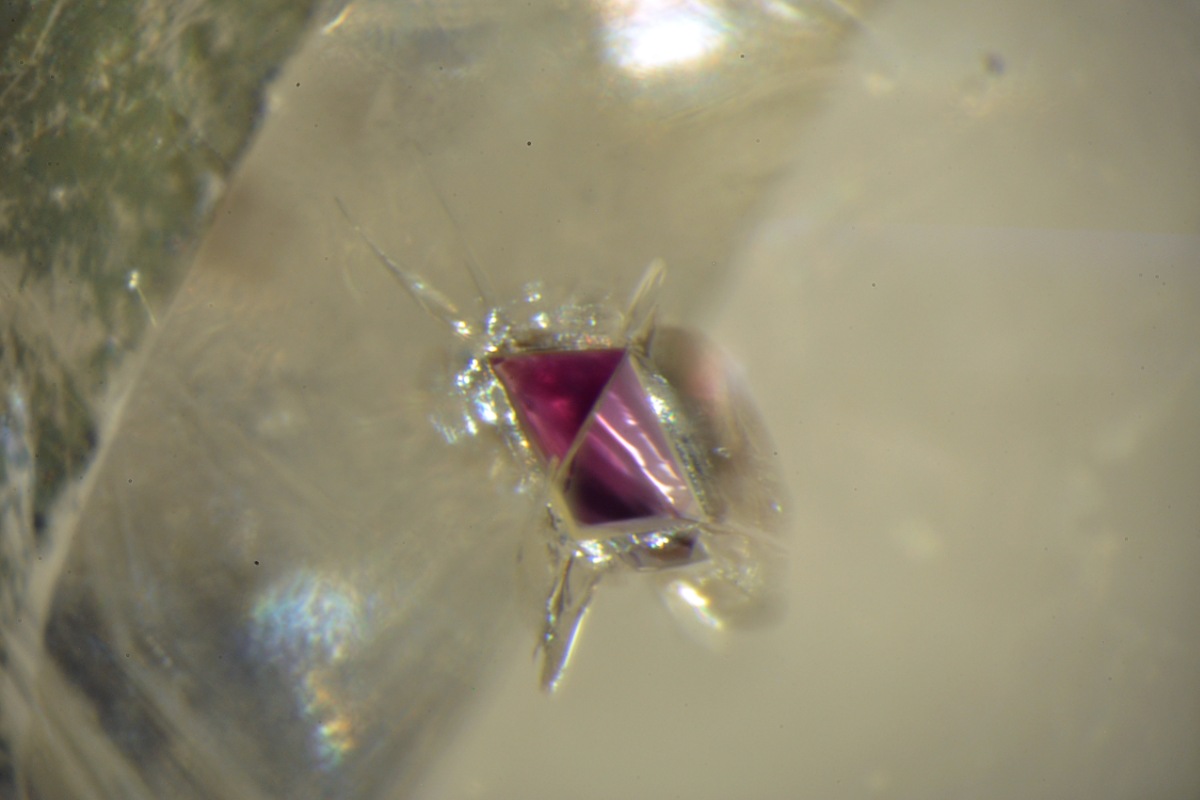
Lherzolitic garnet inclusion inside a diamond collected from the De Beers Group Victor Mine. Photo courtesy of Anetta Banas.
A new discovery has the potential to change how we look for diamonds in Canada and around the world. The research, conducted in a collaboration between University of Alberta geologists and industry partner De Beers Group, highlights the value of lherzolite for diamond exploration. Lherzolite is a common rock type in Earth's mantle but, until now, has only been peripherally associated with diamond formation.
Previously, diamonds in ancient continental regions, such as the Canadian Shield, were thought to have grown mainly in different types of mantle rocks. This assumption, which has guided exploration for decades, is now being turned on its head.
"The outcome of the project fundamentally changes our understanding of where diamonds come from," said Thomas Stachel, professor in the Department of Earth and Atmospheric Sciences and Canada Research Chair in diamonds. "The discovery that economic diamond deposits can come from lherzolitic diamond substrates has the potential to cause diamond companies to retool their approach to exploration."
Canada's diamond industry is the third largest in the world, worth $2 billion.
The research used samples from the De Beers Group Victor Mine, located in the James Bay region of northern Ontario. This area of the Canadian Shield is characterized by a large-scale heating event that occurred approximately one billion years ago, an unusual setting for a diamond mine.
"The ground-breaking work being done through the De Beers Laboratory of Diamond Research, which forms part of the Diamond Research Group at the University of Alberta, is helping us better understand Canada's diverse geology," said Julie Kong, senior exploration manager, De Beers Group Exploration Canada. "We're pleased to be able to support this world-leading institution as their work provides us with new insights that help in our search for diamond-bearing deposits."
The collaborative partnership between De Beers Group and the University of Alberta dates back to 2003. Over the years, the company has contributed over $200,000 in funding for the diamond research lab that bears the company name and to support a variety of research programs, a number of completed post-graduate projects, and two current master's degree projects.
"This research suggests that the results for the Victor Mine may well apply to other regions around the world that experienced geologically 'young' overprint, in particular in Western Canada," added Stachel, who is also the director of the Canadian Centre for Isotopic Microanalysis housed in the Faculty of Science. "In the long run, this could make a big difference in diamond exploration."
The study was a collaborative research and development project that involved undergraduate, graduate, and staff researchers, including students in the NSERC CREATE-funded Diamond Exploration Research and Training School (DERTS), as well as geologists from De Beers.
The University of Alberta, Stachel notes, is uniquely equipped to conduct this type of research with nearly $30 million invested into analytical facilities that allow probing the age and origins of diamonds at the micro-analytical level. "We've dated and analyzed the makeup of diamonds, their miniscule inclusions, and the mantle itself. The level of detail collected in this study couldn't be done anywhere else in the world."
This research project was jointly initiated in discussions between Stachel and Kong. Funding for this project was provided by De Beers Group and the Natural Sciences and Engineering Research Council of Canada (NSERC) through a Collaborative Research and Development grant.
The paper, "The Victor Mine (Superior Craton, Canada): Neoproterozoic lherzolitic diamonds from a thermally-modified cratonic root," was published in Mineralogy and Petrology (doi: 10.1007/s00710-018-0574-y).